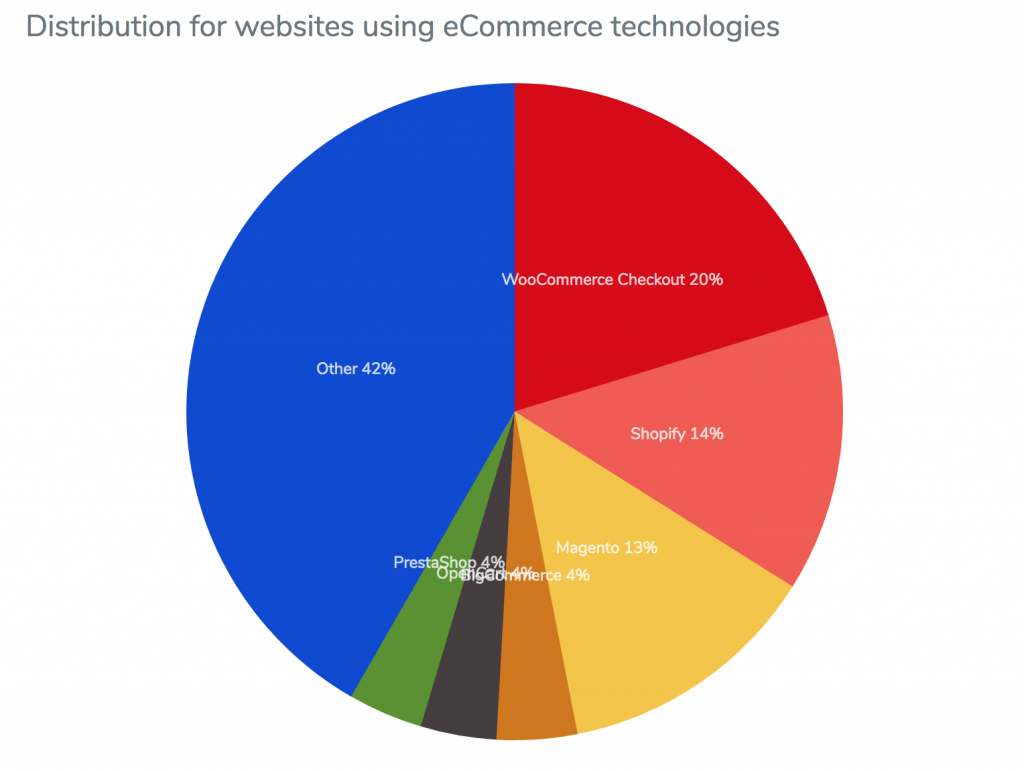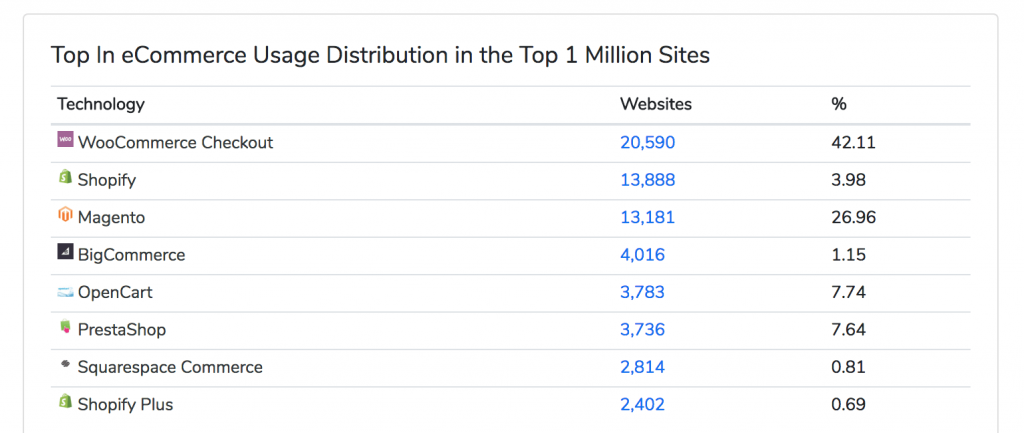
Comparing ecommerce platforms is not a task for the faint-hearted. There are thousands of posts comparing the good the bad and the ugly. So why read this one? Well, for starters it’s a quick read. By the end you will have a little more insight into why businesses with complex requirements choose WooCommerce. If you want to compare features, this is probably not the post for you. If you want to know why WooCommerce is a good option for more complex online shopping, please do read on.
WooCommerce – The market leader
According to the WooCommerce homepage the number of downloads, at the time of this article, was 47,952,849. For those of you new to WooCommerce, it’s more of an ecosystem than a platform. With hundreds of free and paid plugins, WooCommerce positions itself as ‘the most customizable eCommerce platform for building your online business’.
Given that WooCommerce is one of the top 10 WordPress plugins of all time, it’s no surprise Automattic, the company behind WordPress, acquired WooCommerce in 2015 for a reported $30m. At the time their largest rival, Shopify was valued at $1b, so it appears they picked up a bargain! But what did Automattic actually get for their money, and what does this mean for online store owners?
WooCommerce still holds a commanding lead, the chart above created by Builtwith shows WooCommerce holding 20% of the ecommerce technology market, with Shopify not too far behind at 14%. Interestingly when we look at the stats from the top 1 million websites, WooCommerce extends its lead to just over 42%, whilst Shopify drops under 4%. Magento makes an appearance at a notable 27%. If you are curious about who’s using WooCommerce, well, the US has over 4.6m installs, followed by the UK at 402,495, then Germany at 282,553.
WordPress has their own take on things. It’s hard to tell exactly where the stats are taken from, but the official line from WordPress.org is “WooCommerce now powers 30% of all online stores — more than any other platform.” It’s a bold statement and one that sits comfortably alongside the equally impressive “WordPress powers 31% of the internet”. So Automattic has secured another majority share of the web publishing market, all in the name of democratizing the web, as Matt Mullenweg might say.
What happens when things start to get complicated?
WooCommerce might have some impressive stats, but what happens when the requirement of an ecommerce site starts to drift outside the realms of the tradition online shopping experience? Can WooCommerce standup to the challenge of complex integrations with other data services, such as CRMs or ERPs?
At this point, almost all the online comparisons posts become irrelevant. The price of themes and plugins are the least of the shop owners concern. Attention drifts towards much more probing issues, such as supporting multiple product types on the same site, including physical and virtual events and subscriptions, and concerns over scalability and flexibility move to centre stage.
PEI Media is an international financial media group that produces editorial, data, event and advertising products for alternative asset classes within the private equity market. The company was facing this very decision. They needed both an ecommerce solution and a sophisticated editorial workflow.
Chief Technology and Information Officer, Tony Skeggs summed up the challenges of the project;
“Technical decisions made years earlier by people no longer in the business had burdened us with legacy website software that was no longer up to the job. For example, to publish or change content – even perhaps just fixing a spelling mistake – was an overnight task that involved rebuilding the entire website and its thousands of articles.”
Understandably, this had contributed to the business developing a culture of techno-fear and a skepticism of all things digital. The task was then to redevelop the company’s multi-brand portfolio, comprising eight websites. The company’s specialist business intelligence premium products were to be provided via self-service Ecommerce, while the platforms needed to offer best-of-breed editorial tools and a great-looking front end.
After running serval live tests, the company chose the combination or WordPress + WooCommerce, layered with further integration, including identity and email management. One of the vital components was Blaize, which provides a proxy that sits in front of the WordPress site and manipulates the pages it serves as they are requested. Identity and access modules restrict content access only to those that should have it.
Following the launch of the PEI project, there has been a marked increase in traffic, based on comparable samples just before and after launch, and which has been maintained since launch. For one site, total traffic has increased by 23% and organic traffic is up by 27%; and for the other, mobile traffic has increased by 20% and organic traffic by 40%.
How do you know if WooCommerce + WordPress is right for your complex project?
As mentioned before, platform comparisons are aplenty. But rarely do they consider, non-standard requirements. So to help you weigh up the options, here are a few pointers specifically aimed at complex projects with unusual challenges.
- WooCommerce is extremely popular, not a reason in itself to choose a platform, but an indication of what the market is doing. The stats may be hard to qualify, but we do know WooCommerce is still the leading ecommerce platform and it’s not about to give up the title any time soon. In other words, it’s solid and it will be here for the foreseeable future.
- Finding a developer is easy. Due to WordPress having such a strong hold on the CMS market, it’s only natural all those developers will turn to WooCommerce as a solution for their clients. From freelancers to agencies like Angry Creative, the level of expertise can vary, but the choice is abundant. For those thinking long term, it’s good to know you won’t be stuck with a supplier if things go pear-shaped.
- WooCommerce integrates. With a growing collection of over 300 plugins, WooCommerce is often the first stop on the development roadmap for ecommerce solution providers. Once you start to get into custom integration, a good agency will be able to advise on the best solution. Not to mention the WordPress REST API, which opens up a whole world of possibilities.
- It’s best friends with WordPress. This one might seem obvious, but the fact that WooCommerce plays so nicely with WordPress means your website technology stack is super flexible. If ecommerce functionality is not the only concern and content has a big role to play, you should be asking yourself this… do I just need an ecommerce platform or do I need the world’s top publishing platform as well?
So when things get a little bit complicated and you can’t find the exact solution, it’s worth bearing in mind WooCommerce and WordPress has the ultimate flexibility. Oh and by the way, yes it can scale.
You may also be interested in these articles
Brexit for WooCommerce sellers
The impact of Brexit is huge. There are very many implications for those in e-commerce businesses…
Read more
Brexit for WooCommerce sellers
Cynefin: a valuable framework to classify, communicate and respond to tasks in digital projects
Cynefin. At Angry Creative we think it’s a vital part of digital projects. It helps us to underst…
Read more
Cynefin: a valuable framework to classify, communicate and respond to tasks in digital projects
Web fonts for WordPress
Fonts control how your text is displayed – how the letters actually look. web-safe fonts. W…
Read more
Web fonts for WordPress
Subscribe to our newsletter for tips, inspiration and insight about WordPress and WooCommerce and the digital world beyond.
Time to take the next step towards a more effective website?
Contact us, and we can talk more about how we can take your business to the next level together.

